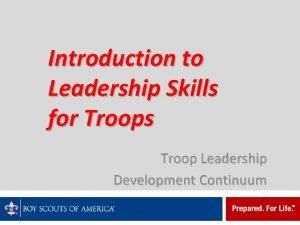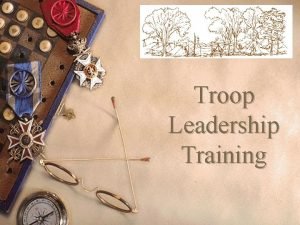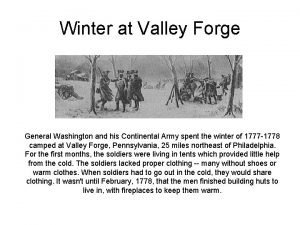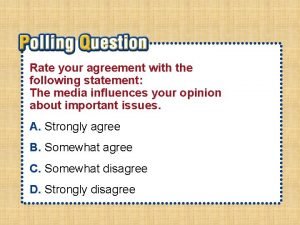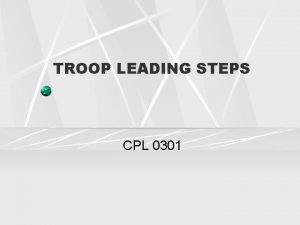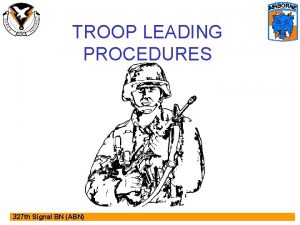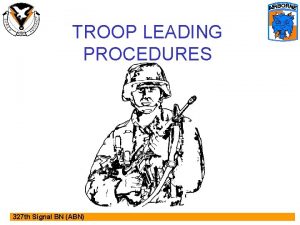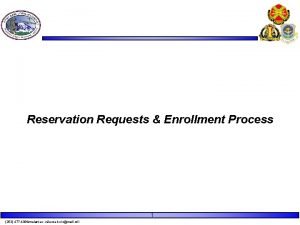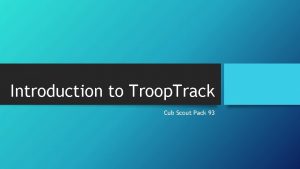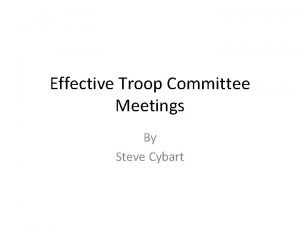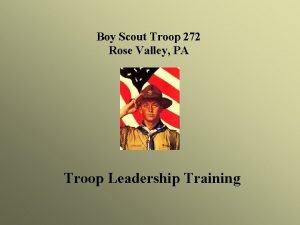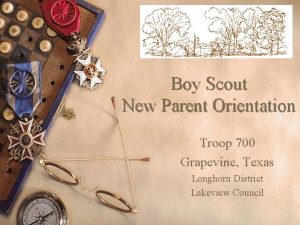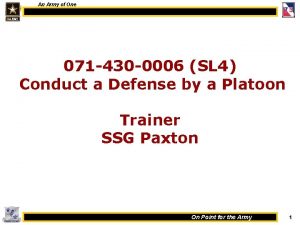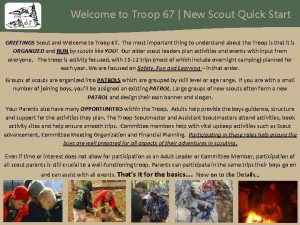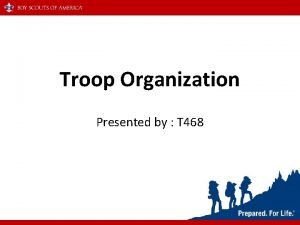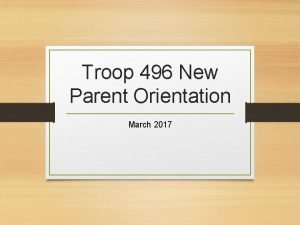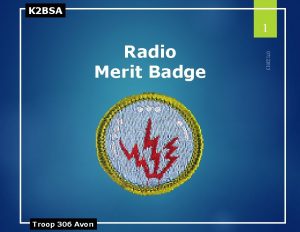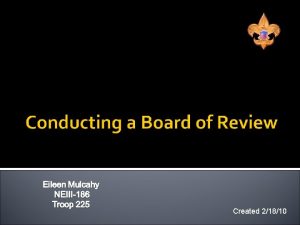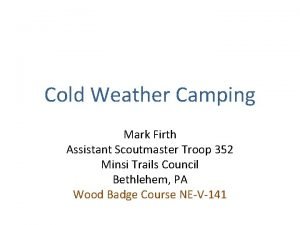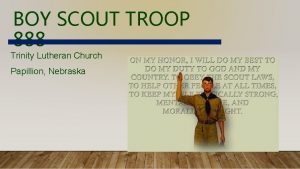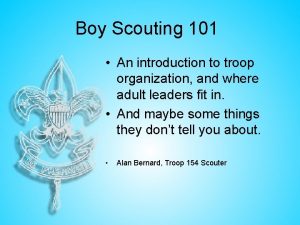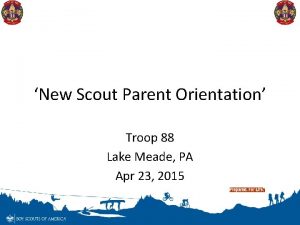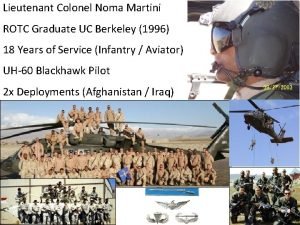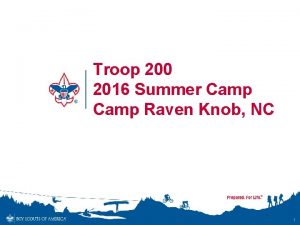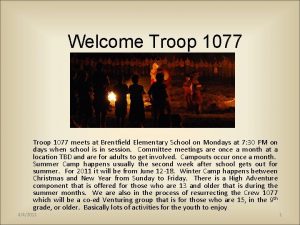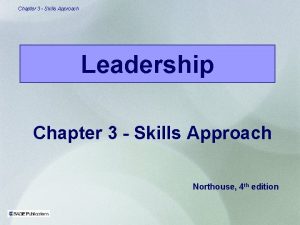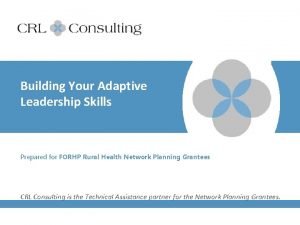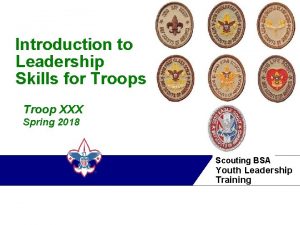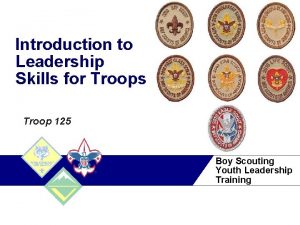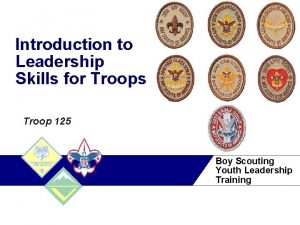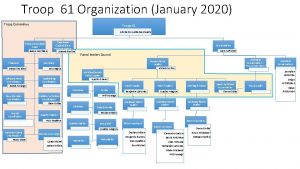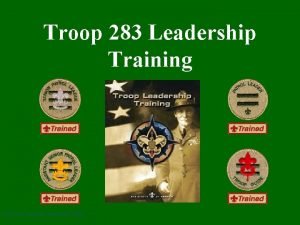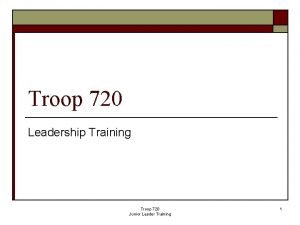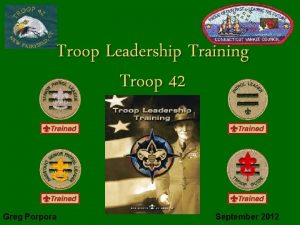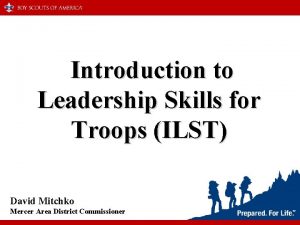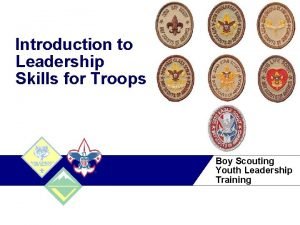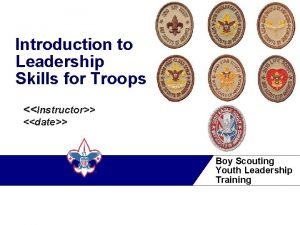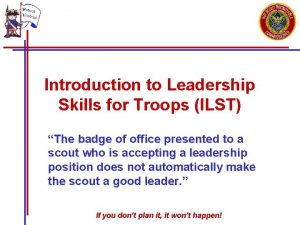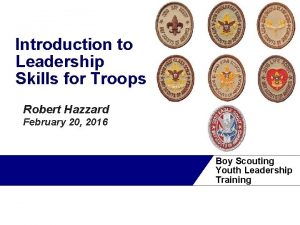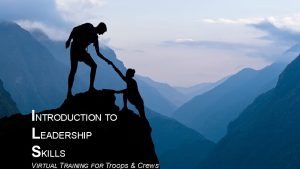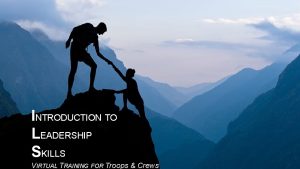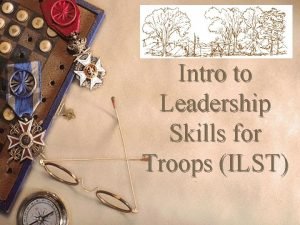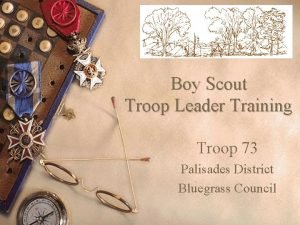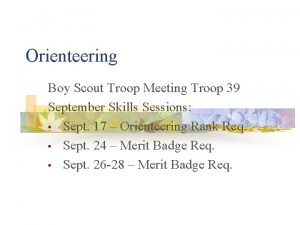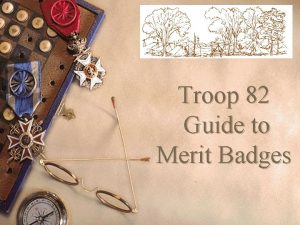Introduction to Leadership Skills for Troops Troop Leadership




































































































































- Slides: 132

Introduction to Leadership Skills for Troops Troop Leadership Development Continuum

Introduction to Leadership Skills for Troops Purpose: • To provide the foundational unit-level Leadership skills every Scout should know • To give every Scout a clearer picture of how his position fits in the Troop and how he can make a difference.

Introduction to Leadership Skills for Troops Learning Objectives: • To help youth Leaders to understand the responsibilities of a Leader, and prepare them to effectively fill a position of responsibility

Introduction to Leadership Skills for Troops Learning Objectives: • To equip Scout Leaders with the tools that are needed to fulfill their responsibilities as a Troop or Patrol level Leader

Introduction to Leadership Skills for Troops Learning Objectives: • To equip Scout Leaders with the basic concept of the Stages of Team Development in order to best fulfill their responsibilities as a Troop or Patrol level Leader

Introduction to Leadership Skills for Troops Presented in three “Modules” • Module I – Troop Organization • Module II – “Tools of the Trade” • Module III – Leadership and Teamwork

Introduction to Leadership Skills for Troops Module I – Troop Organization

Introduction to Leadership Skills for Troops Leaders need to understand the various leadership roles within the Troop, both elected and appointed, as well as the dynamics of having everyone be involved in the success of Troop activities

Introduction to Leadership Skills for Troops • In Scouting, a Troop’s vision is something developed and shared by all members. It identifies where the troop is going, and what it wants to accomplish. • We will discuss vision more thoroughly in Module III, but each Scout should be thinking about his vision of success in his position, as well as his vision for the Troop.

Introduction to Leadership Skills for Troops Troop Leadership Positions “Green Bar” Leaders § § Senior Patrol Leader Assistant Senior Patrol Leaders Patrol Leader Assistant Patrol Leader

Introduction to Leadership Skills for Troops Troop Leadership Positions Support Leaders § § Troop Guide Instructor Quartermaster Scribe

Introduction to Leadership Skills for Troops Troop Leadership Positions Support Leaders § § Librarian Historian Order of the Arrow Representative Chaplain Aid

Introduction to Leadership Skills for Troops Troop Leadership Positions Support Leaders § Leave No Trace Trainer § Webmaster

Introduction to Leadership Skills for Troops Common attributes shared by all Scouting Leaders in a Troop: • Set and enforce the tone for good Scout behavior within the Troop • Set an example • Wear the Scout uniform correctly and with pride

Introduction to Leadership Skills for Troops Common attributes shared by all Scouting Leaders in a Troop: • Live by the Scout Oath and Scout Law • Show and help develop Scout spirit • Willingness to train to best serve the members of the Troop

Introduction to Leadership Skills for Troops Leadership Exercise I

Introduction to Leadership Skills for Troops • Scouts plan and implement the Troop program. Scouts serve in positions of responsibility to make that happen • Scouting is designed to help Scouts prepare to participate in, and give leadership to, American society

Introduction to Leadership Skills for Troops • The Patrol Leaders’ Council plans and runs the Troop’s program and activities. • The SPL runs the Patrol Leaders’ Council meeting, and the adult leaders attend as coaches, mentors, and resources; providing suggestions and guidance whenever it will enhance the program for the Troop and Scouts

Introduction to Leadership Skills for Troops Just as adult leaders must step back and enable Scout Leaders to lead the Troop, senior Scout Leaders must work with, train, and encourage less-senior Scout Leaders in the Troop to fulfill their roles and practice their own leadership skills.

Introduction to Leadership Skills for Troops Leadership Exercise II

Introduction to Leadership Skills for Troops Each Scout will take 5 minutes to develop their own definition of Leadership which we then use in defining Leadership for our Troop.

Introduction to Leadership Skills for Troops Some key leadership points: • • • Teamwork Use each other’s strengths Don’t try to do it all yourself Do what you said you will do Being reliable Keeping each other informed

Introduction to Leadership Skills for Troops Some key leadership points: • • • Being responsible Care for others Delegate Set the example Praise in public, criticize in private Lead yourself

Introduction to Leadership Skills for Troops Tips on being a good leader: • Keep your word. Don’t make promises you can’t keep. • Be fair to all. A good Leader shows no favorites. Don’t allow friendships to keep you from being fair to all members of your Troop or Patrol.

Introduction to Leadership Skills for Troops Tips on being a good leader: • Be a good communicator. You don’t need a commanding voice to be a good leader, but you must be willing to step out front with an effective “Let’s go. ” A good leader knows how to get and give information so that everyone understands what’s happening.

Introduction to Leadership Skills for Troops Tips on being a good leader: • Be flexible. Not everything goes as planned. Be prepared to shift to “Plan B” when “Plan A” doesn’t work. Always think about a “Plan C. ” • Be organized. The time you spend planning will be repaid many times over.

Introduction to Leadership Skills for Troops Tips on being a good leader: • Delegate. Some leaders assume that the task will not get done unless they do it themselves. Most people like to be challenged with a task. Empower your team members to do things they have never tried.

Introduction to Leadership Skills for Troops Tips on being a good leader: • Set an example. The most important thing you can do is lead by example. Whatever you do, your Troop members are likely to do the same. A cheerful attitude can keep everyone’s spirits up.

Introduction to Leadership Skills for Troops Tips on being a good leader: Setting an example is consists of three critical traits: § Appearance § Conduct § Attitude

Introduction to Leadership Skills for Troops Tips on being a good leader: • Be consistent. Nothing is more confusing than a leader who acts one way one moment and another way a short time later. If your Troop and Patrol knows what to expect from you, they will more likely respond positively to your leadership

Introduction to Leadership Skills for Troops Tips on being a good leader: • Give praise. The best way to get credit is to give it away. Often a “nice job” is all the praise necessary to make a Scout feel he is contributing to the efforts of the Troop.

Introduction to Leadership Skills for Troops Tips on being a good leader: • Ask for help. Don’t be embarrassed to ask for help. You have many resources at your disposal. When confronted with a situation you don’t know how to handle, ask someone with more experience for some advice and direction.

Introduction to Leadership Skills for Troops Servant Leadership

Introduction to Leadership Skills for Troops Introduction to Servant Leadership It is about a choice to lead. It is about a choice to give rather than to receive.

Introduction to Leadership Skills for Troops • We trust effective leaders because they care about us and about helping others succeed. That is the true role of any leader: help other members of the group to succeed.

Introduction to Leadership Skills for Troops • Servant Leaders understand what success looks like not only for the group but for each member of every team. • They do everything they can to help the Troop and each member succeed.

Introduction to Leadership Skills for Troops • Servant Leaders help guide the Troop through all of the tasks that must be accomplished. Troop Leaders help manage this process.

Introduction to Leadership Skills for Troops • They focus on how to make every member successful in assigned tasks so that the Troop will come together quickly as a team

Introduction to Leadership Skills for Troops Servant leaders want to lead because they know they can help make a difference and provide a better experience for every individual. They accept responsibility for, but are never “in charge of” making things happen.

Introduction to Leadership Skills for Troops Key Points: • Servant leadership is about making the choice to lead, to give more than you receive, and to make a difference. • Effective servant leaders care about others, about helping others succeed, and about making the group successful.

Introduction to Leadership Skills for Troops Key Points: • It is important to introduce and reinforce the idea and value of servant leadership in our Scout and adult Leaders. • A good group leader is focused on the success of the members of his team as individuals and as a team.

Introduction to Leadership Skills for Troops Key Points: • Servant leaders understand what success looks like not only for the team as a whole, but also for each member of the team. • Servant leaders want to lead because they know they can help make a difference and provide a better experience for every individual.

Introduction to Leadership Skills for Troops Key Points: • Patrol and Troop members can see when a Leader cares about their needs and is focused on their success, which earns him the group’s respect. When he has that respect, the Scout has earned the title and role of Leader.

Introduction to Leadership Skills for Troops The type of Leadership that you practice is a choice § Where is the focus § What is at the core

Introduction to Leadership Skills for Troops Pares inter Primus “First Amongst Equals”

Introduction to Leadership Skills for Troops Questions Comments Feedback

Introduction to Leadership Skills for Troops End of Module I

Introduction to Leadership Skills for Troops Module II – “Tools of the Trade”

Introduction to Leadership Skills for Troops Introduction This module introduces the basic leadership tools of communicating, planning, evaluating, and how to use the Teaching EDGE effectively in one’s leadership role.

Introduction to Leadership Skills for Troops Communicating - the skills of being an effective listener communicator are valuable tools for any leader. Planning - proper planning makes the difference in almost all Scouting activities.

Introduction to Leadership Skills for Troops Evaluating using the Stop, Start, Continue method – an objective evaluation tool for use after every activity and event Teaching EDGE -The Teaching EDGE method can be used any time a leader is helping others learn

Introduction to Leadership Skills for Troops Communicating

Introduction to Leadership Skills for Troops The Greek philosopher Aristotle broke communications down into three main parts and these remain constant today, with the addition of one minor part: The Sender The Message The Receiver

Introduction to Leadership Skills for Troops The influence of The Environment can not be ignored, and can have a significant impact on the three major parts of the communication process. This applies to all forms of communication: verbal, written, signaling, and teaching.

Introduction to Leadership Skills for Troops

Introduction to Leadership Skills for Troops Leadership Exercise III

Introduction to Leadership Skills for Troops Key Points: • Be as clear as possible with your message. • Plan ahead and prepare. • People will do what they think you told them - even if it’s not what you meant.

Introduction to Leadership Skills for Troops Key Points: • Allow your listeners to ask questions and get a clear understanding of your message • You may want to ask your listeners to tell you what they think your message is, to confirm that they received it correctly.

Introduction to Leadership Skills for Troops Key Points: • As the sender, the message often seems clearer to you than to the receiver. • Messages flow both ways - from sender to receiver and back. Both sender and receiver are responsible for good communications to work.

Introduction to Leadership Skills for Troops Some communicating tips when putting out information: • Before you begin to pass out information, take a moment to organize your thoughts. You may want to write a few notes to remind yourself of the points you want to cover.

Introduction to Leadership Skills for Troops Some communicating tips when putting out information: • Have the team gather in a place free of distractions. Do not begin until you have everyone’s attention.

Introduction to Leadership Skills for Troops Some communicating tips when putting out information: • You can use the Scout sign as a signal that it is time for everyone to stop other discussions and focus on the business at hand

Introduction to Leadership Skills for Troops Some communicating tips when putting out information: • Speak clearly. Make eye contact with your listeners. As you finish explaining each item, ask if there any questions.

Introduction to Leadership Skills for Troops Some communicating tips when putting out information: • Repeat important facts such as dates, times, and places. • If possible, ask the Troop or Patrol Scribe to make and distribute notes of the discussion

Introduction to Leadership Skills for Troops Planning – The Key To Success

Introduction to Leadership Skills for Troops Second only to communicating, planning is an essential skill for every effective leader. You will notice that things you thought “just happened” in the Troop are the result of planning and preparing for things to happen.

Introduction to Leadership Skills for Troops Generally, the better planned an activity, the more fun the group will have and the more successful the event will be. Conversely, everyone suffers when the person responsible has not planned properly for the group to participate in an activity.

Introduction to Leadership Skills for Troops Planning is really just thinking ahead – thinking about what’s needed to get the outcome you want to have happen. In planning Scouting activities, usually the desired outcome is that the planned activity is successful - and that the participants had fun and positive experienced.

Introduction to Leadership Skills for Troops Planning is figuring out what it will take to make things come together smoothly To start planning, it often helps to start asking yourself questions, then coming up with a set of answers. Start by answering the basic questions of who, what, when, where, and how questions.

Introduction to Leadership Skills for Troops What do we want to do? What is the desired outcome? Where is a suitable site? How will we get there? What will we do once we get there?

Introduction to Leadership Skills for Troops What equipment do we need? Where do we get that equipment? Who is responsible for getting the equipment?

Introduction to Leadership Skills for Troops Who is participating? When is the activity? Do we need permits or permission? What will we do if. . . ?

Introduction to Leadership Skills for Troops Use the Cornerstone planning method to insure that all of your planned activities will contribute to the overall goals of the Troop

Introduction to Leadership Skills for Troops Annual Program Key Activity Areas • Advancement • Recruiting and Retention • Outdoor Program • Service • Faith • Leadership Development

Introduction to Leadership Skills for Troops After you get through the basics in planning, spend time thinking through some “what do we do if ‘the unexpected’ happens? ” kinds of questions. That will help you Be Prepared when things don’t go as originally planned.

Introduction to Leadership Skills for Troops The most important focus is on the “who”: “Who is responsible for making that part happen? ” or “Who will bring that item? ” Sometimes teams work out a good plan, but then the leader doesn’t assign specific people to complete every needed task.

Introduction to Leadership Skills for Troops Figuring out what’s needed is important, but assigning someone to take care of each task is essential. Be certain that someone is assigned to complete every needed task, and don’t presume that “someone” will step up and take care of something.

Introduction to Leadership Skills for Troops Planning Exercise

Introduction to Leadership Skills for Troops Annual Program Key Activity Areas • Advancement • Recruiting and Retention • Outdoor Program • Service • Faith • Leadership Development

Introduction to Leadership Skills for Troops Keys to Successful Planning Plan your planning: • focus on important things early in the planning process. • identify the big areas that are going to need to be thought about and make sure you cover each one thoroughly.

Introduction to Leadership Skills for Troops Keys to Successful Planning • Someone needs to take the lead in the planning process. • Designate a scribe. Write down the plan. • Think through some key questions in each key activity area

Introduction to Leadership Skills for Troops Keys to Successful Planning • Develop answers to each question • Write down tasks that need to be accomplished to make the project a success • Assign owners to each task, and set a goal for completion as needed

Introduction to Leadership Skills for Troops Keys to Successful Planning • Assign someone to follow up and verify that needed things are getting done. • Take enough time to plan well. If necessary, schedule more time later. • Do not presume needed things will “just happen. ”

Introduction to Leadership Skills for Troops When planning an activity, don’t presume that something needed will be there or that it will just happen; don’t presume that someone will take care of something because it seems obvious or because he usually does it.

Introduction to Leadership Skills for Troops Include every responsibility in your plans and assign an owner. Check on it - then you’ll know that it’s taken care of.

Introduction to Leadership Skills for Troops As you become more aware of the value of planning and how it can affect the success of activities, you may also notice when others in your Troop - either Scout Leaders or adult leaders - have not put enough time or effort into planning the activity.

Introduction to Leadership Skills for Troops Ensure the members of the Troop find ways to provide constructive feedback to each other to ensure that those who don’t properly plan are helped to understand that it is not acceptable. Everyone suffers when the person responsible for making something happen doesn’t plan properly.

Introduction to Leadership Skills for Troops If you feel that you’re doing all you can or you are running out of ideas, ask for help. When you DO put in the proper planning time, the Scouts will see that you care enough to put your energy into planning the best possible program for the Troop, and they will see you as a real leader.

Introduction to Leadership Skills for Troops Stop, Start, Continue

Introduction to Leadership Skills for Troops Evaluating using the Stop, Start, Continue method is an objective way to evaluate an event, meeting or activity with the goal of improving at every step of the process

Introduction to Leadership Skills for Troops Using the SSC Method: STOP - what are we doing that isn’t working; did what we have planned work the way that we thought it would work.

Introduction to Leadership Skills for Troops Using the SSC Method: START - what should we start doing that will work or has worked for others or in the past? What should be start using in our plans or planning process?

Introduction to Leadership Skills for Troops Using the SSC Method: CONTINUE - what are we doing that works well, and should continue to do.

Introduction to Leadership Skills for Troops An evaluation using the Stop, Start, Continue method should be conducted after every event, meeting or activity with the goal of improving the planning and execution of future Troop activities.

Introduction to Leadership Skills for Troops The Teaching EDGE

Introduction to Leadership Skills for Troops The EDGE (Explain, Demonstrate, Guide, Enable) method is the primary training method to teach skills in Scouting. The four-step EDGE process is a simple method for teaching any skill.

Introduction to Leadership Skills for Troops Explain – explain in step by step detail how something is done Demonstrate - demonstrate the task while explaining again. This gives the learner a clear understanding of what success looks like

Introduction to Leadership Skills for Troops Guide - the learner tries the skill while the trainer guides him through it. The trainer gives instant feedback as the learner practices the skill. The trainer should not rush through this level of instruction.

Introduction to Leadership Skills for Troops Enable - the learner works independently under the watchful eye of the trainer. The trainer helps remove any obstacles to success, and continues to provide feedback as needed, thus enabling the learner to succeed.

Introduction to Leadership Skills for Troops EDGE Exercise

Introduction to Leadership Skills for Troops Using the EDGE Method: • What happened during the Explain step? • What happened during the Demonstrate step? • What happened during the Guide step? • What happened during the Enable step?

Introduction to Leadership Skills for Troops Using the EDGE Method: • Did parts go too fast or too slow for you? • What could the trainer do to address that? • Did the learners ask questions? Did the trainer answer them?

Introduction to Leadership Skills for Troops Using the EDGE Method: • Did the trainer ask questions of the learners to ensure they were following the steps of the instruction process? • How did the trainer know the learners had learned the skill?

Introduction to Leadership Skills for Troops Using the EDGE Method: • What other skills could we teach using this method? • How could you as a leader use the EDGE method with your Patrol?

Introduction to Leadership Skills for Troops Questions Comments Feedback

Introduction to Leadership Skills for Troops End of Module II

Introduction to Leadership Skills for Troops Leadership and Teamwork

Introduction to Leadership Skills for Troops The Stages of Team Formation

Introduction to Leadership Skills for Troops FORMING • High expectations, no production (yet) • No “Team” • All Leadership from outside the group

Introduction to Leadership Skills for Troops STORMING • Low expectations, low morale, low skill • No “Team” unity • All Leadership from outside the group

Introduction to Leadership Skills for Troops NORMING • Expectations, morale and skill rising • “Team” coming together • Leadership coming from inside the group

Introduction to Leadership Skills for Troops PERFORMING • High expectations, high production, high morale and skill • True “Team” • All Leadership from within the group

Introduction to Leadership Skills for Troops Understanding the stages enable us to anticipate what a team is likely to go through. Understanding the stages enable us to use appropriate strategies to smooth the progress of a team as it evolves.

Introduction to Leadership Skills for Troops Different teams may proceed through different stages at different speeds. Members of a team should avoid making self-fulfilling prophecies about how long each stage will last.

Introduction to Leadership Skills for Troops A team may sometimes regress to an earlier stage. It is possible for a team to be in different stages with respect to different aspects of its vision.

Introduction to Leadership Skills for Troops Recognizing the stages of team formation allows Leaders to use the best Leadership style for the team and the situation.

Introduction to Leadership Skills for Troops The Values of Scouting

Introduction to Leadership Skills for Troops Viewing the Scout Oath from the point of view of a Leader How does it change the way that you now see the Scout Oath?

Introduction to Leadership Skills for Troops The Vision of Our Troop A Vision is a picture of Future Success Where do we want to be in 3 months? - 6 months? - 12 months?

Introduction to Leadership Skills for Troops The Vision of Our Troop How does our vision fit with the model of Servant Leadership?

Introduction to Leadership Skills for Troops The Vision of Our Troop • • Need to listen and gather suggestions Achieve consensus Set & Maintain Standards Serve the Scouts who have chosen you as Leader

Introduction to Leadership Skills for Troops The Vision of Our Troop Creating a Vision and a Vision Statement

Introduction to Leadership Skills for Troops Know your Responsibilities Use the Tools of the Trade • • Communication Planning Evaluate using SSC The Teaching EDGE

Introduction to Leadership Skills for Troops Build your Patrol into a High. Functioning Team, which will build the Troop into a unit of excellence Build Trust, Make a Difference

Introduction to Leadership Skills for Troops The only thing that is asked is that you do your very best for the members of the team that you have been chosen to serve.

Introduction to Leadership Skills for Troops Wrap-up

Introduction to Leadership Skills for Troops Purpose: • To provide the foundational unit-level Leadership skills every Scout should know • To give every Scout a clearer picture of how his position fits in the Troop and how he can make a difference.

Introduction to Leadership Skills for Troops Learning Objectives: • To help youth Leaders to understand the responsibilities of a Leader, and prepare them to effectively fill a position of responsibility

Introduction to Leadership Skills for Troops Learning Objectives: • To equip Scout Leaders with the tools that are needed to fulfill their responsibilities as a Troop or Patrol level Leader

Introduction to Leadership Skills for Troops Learning Objectives: • To equip Scout Leaders with the basic concept of the Stages of Team Development in order to best fulfill their responsibilities as a Troop or Patrol level Leader

And when you are placed in a position of responsibility, never forget - “Attitude Reflects Leadership”

Introduction to Leadership Skills for Troops Troop Leadership Development Continuum
 Introduction to leadership skills for troops
Introduction to leadership skills for troops Troop leadership training
Troop leadership training American troops fight the korean war 48a answer key
American troops fight the korean war 48a answer key Troops to energy program
Troops to energy program Defeat in new york
Defeat in new york Washington and lafayette inspect the troops at valley forge
Washington and lafayette inspect the troops at valley forge Tools for troops
Tools for troops Why was ben milam trying to rally the texan troops?
Why was ben milam trying to rally the texan troops? Lesson 3 the home front and civilians
Lesson 3 the home front and civilians The king hired german troops to fight in america.
The king hired german troops to fight in america. Kontinuitetshantering i praktiken
Kontinuitetshantering i praktiken Typiska novell drag
Typiska novell drag Tack för att ni lyssnade bild
Tack för att ni lyssnade bild Vad står k.r.å.k.a.n för
Vad står k.r.å.k.a.n för Shingelfrisyren
Shingelfrisyren En lathund för arbete med kontinuitetshantering
En lathund för arbete med kontinuitetshantering Kassaregister ideell förening
Kassaregister ideell förening Personlig tidbok
Personlig tidbok A gastrica
A gastrica Vad är densitet
Vad är densitet Datorkunskap för nybörjare
Datorkunskap för nybörjare Stig kerman
Stig kerman Debattartikel mall
Debattartikel mall Autokratiskt ledarskap
Autokratiskt ledarskap Nyckelkompetenser för livslångt lärande
Nyckelkompetenser för livslångt lärande Påbyggnader för flakfordon
Påbyggnader för flakfordon Tryck formel
Tryck formel Svenskt ramverk för digital samverkan
Svenskt ramverk för digital samverkan Jag har nigit för nymånens skära text
Jag har nigit för nymånens skära text Presentera för publik crossboss
Presentera för publik crossboss Jiddisch
Jiddisch Plats för toran ark
Plats för toran ark Klassificeringsstruktur för kommunala verksamheter
Klassificeringsstruktur för kommunala verksamheter Epiteltyper
Epiteltyper Claes martinsson
Claes martinsson Cks
Cks Lågenergihus nyproduktion
Lågenergihus nyproduktion Bra mat för unga idrottare
Bra mat för unga idrottare Verktyg för automatisering av utbetalningar
Verktyg för automatisering av utbetalningar Rutin för avvikelsehantering
Rutin för avvikelsehantering Smärtskolan kunskap för livet
Smärtskolan kunskap för livet Ministerstyre för och nackdelar
Ministerstyre för och nackdelar Tack för att ni har lyssnat
Tack för att ni har lyssnat Hur ser ett referat ut
Hur ser ett referat ut Redogör för vad psykologi är
Redogör för vad psykologi är Stål för stötfångarsystem
Stål för stötfångarsystem Atmosfr
Atmosfr Borra hål för knoppar
Borra hål för knoppar Vilken grundregel finns det för tronföljden i sverige?
Vilken grundregel finns det för tronföljden i sverige? Formula varians
Formula varians Tack för att ni har lyssnat
Tack för att ni har lyssnat Rita perspektiv
Rita perspektiv Verksamhetsanalys exempel
Verksamhetsanalys exempel Tobinskatten för och nackdelar
Tobinskatten för och nackdelar Blomman för dagen drog
Blomman för dagen drog Datumr
Datumr Egg för emanuel
Egg för emanuel Elektronik för barn
Elektronik för barn Antikt plagg
Antikt plagg Strategi för svensk viltförvaltning
Strategi för svensk viltförvaltning Kung som dog 1611
Kung som dog 1611 Ellika andolf
Ellika andolf Romarriket tidslinje
Romarriket tidslinje Tack för att ni lyssnade
Tack för att ni lyssnade Multiplikation med uppställning
Multiplikation med uppställning Upprepningar i prosa
Upprepningar i prosa Inköpsprocessen steg för steg
Inköpsprocessen steg för steg Rbk-mätning
Rbk-mätning Ledarskapsteorier
Ledarskapsteorier Hur stor skarns är det för ett barn att få cancer
Hur stor skarns är det för ett barn att få cancer Myndigheten för delaktighet
Myndigheten för delaktighet Trög för kemist
Trög för kemist Sju principer för tillitsbaserad styrning
Sju principer för tillitsbaserad styrning Läkarutlåtande för livränta
Läkarutlåtande för livränta Karttecken ruin
Karttecken ruin Skapa med geometriska former
Skapa med geometriska former Texter för hinduer tantra
Texter för hinduer tantra Vanlig celldelning
Vanlig celldelning Bris för vuxna
Bris för vuxna Big brother rösta
Big brother rösta Troop leading steps
Troop leading steps Troop leading procedures
Troop leading procedures 8 troop leading procedures
8 troop leading procedures Troop 110
Troop 110 Jblm troop schools
Jblm troop schools Troop 149
Troop 149 Expected armored cavalry troop symbol
Expected armored cavalry troop symbol Troop track
Troop track Troop 19
Troop 19 Boy scout troop committee organization chart
Boy scout troop committee organization chart Troop 272 rose valley
Troop 272 rose valley Troop 700
Troop 700 Troopmaster login
Troopmaster login Troop leading procedures army
Troop leading procedures army Troop 67
Troop 67 Boy scout troop committee organization chart
Boy scout troop committee organization chart Troop 496
Troop 496 Troop 2 newark de
Troop 2 newark de Troop 344
Troop 344 Troop 306
Troop 306 Four troop
Four troop Troop 225
Troop 225 Troop 352
Troop 352 Troop 700
Troop 700 Troop 888
Troop 888 Troop 101 northborough
Troop 101 northborough Boy scout troop committee organization chart
Boy scout troop committee organization chart Troop elevation pillow
Troop elevation pillow Troop 584
Troop 584 Troop leading procedures
Troop leading procedures Raven knob map
Raven knob map Arion with troop
Arion with troop Troop 1077
Troop 1077 Troop 446 pearland
Troop 446 pearland Intra personal skill
Intra personal skill What is a soft skill
What is a soft skill Ontario skills passport
Ontario skills passport Skills approach to leadership
Skills approach to leadership Leadership skills are defined in the chapter as
Leadership skills are defined in the chapter as What is leadership definition
What is leadership definition Scottish school system
Scottish school system Leadership skills of attila the hun
Leadership skills of attila the hun Leadership through people skills
Leadership through people skills Transferable skills leadership
Transferable skills leadership Transformational leadership degree
Transformational leadership degree Skills approach in leadership
Skills approach in leadership Adaptive leadership skills
Adaptive leadership skills Transactional vs transformational leadership
Transactional vs transformational leadership Situational leadership vs adaptive leadership
Situational leadership vs adaptive leadership Situational leadership vs adaptive leadership
Situational leadership vs adaptive leadership Introduction of communication skills
Introduction of communication skills Introduction to soft skills
Introduction to soft skills Parts of a presentation
Parts of a presentation
